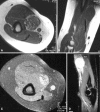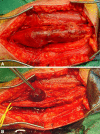A 56-year-old woman with a right arm mass
- PMID: 18288548
- PMCID: PMC2565013
- DOI: 10.1007/s11999-008-0159-x
A 56-year-old woman with a right arm mass
Figures







Similar articles
-
[Intraneural hemangioma of the ulnar nerve].Nervenarzt. 2015 Feb;86(2):197-201. doi: 10.1007/s00115-014-4169-5. Nervenarzt. 2015. PMID: 25575631 German. No abstract available.
-
Intrinsic hemangiomas of the peripheral nerves report of a case and review of the literature.Conn Med. 1998 Apr;62(4):209-13. Conn Med. 1998. PMID: 9611417 Review.
-
Intramuscular thrombosed arteriovenous hemangioma of the upper right arm mimicking a neuroma of the ulnar nerve: case report.Neurosurgery. 2004 Mar;54(3):770-1; discusion 771-2. doi: 10.1227/01.neu.0000109540.92261.44. Neurosurgery. 2004. PMID: 15028157
-
Intraneural hemangioma of digital nerve diagnosed with MR imaging.Skeletal Radiol. 2007 Feb;36(2):157-60. doi: 10.1007/s00256-006-0094-4. Epub 2006 Mar 22. Skeletal Radiol. 2007. PMID: 16552604
-
Intrinsic haemangioma of the median nerve: report of a case and review of the literature.Microsurgery. 2008;28(2):89-90. doi: 10.1002/micr.20456. Microsurgery. 2008. PMID: 18220250 Review.
Cited by
-
A 3D-printed model of axillary cavernous hemangioma.J Vasc Surg Cases Innov Tech. 2025 Jun 18;11(5):101884. doi: 10.1016/j.jvscit.2025.101884. eCollection 2025 Oct. J Vasc Surg Cases Innov Tech. 2025. PMID: 40686578 Free PMC article.
-
Intraneural cavernous hemangioma: a rare case of extrafascicular left ulnar nerve tumor.Am J Blood Res. 2021 Feb 15;11(1):72-76. eCollection 2021. Am J Blood Res. 2021. PMID: 33796392 Free PMC article.
-
Chronic excruciating forearm pain in a child with intra-neural hemangioma: A challenging case report.Int J Surg Case Rep. 2021 Dec;89:106561. doi: 10.1016/j.ijscr.2021.106561. Epub 2021 Nov 3. Int J Surg Case Rep. 2021. PMID: 34864264 Free PMC article.
-
[Intraneural hemangioma of the ulnar nerve].Nervenarzt. 2015 Feb;86(2):197-201. doi: 10.1007/s00115-014-4169-5. Nervenarzt. 2015. PMID: 25575631 German. No abstract available.
References
-
- {'text': '', 'ref_index': 1, 'ids': [{'type': 'DOI', 'value': '10.1053/crad.1999.0343', 'is_inner': False, 'url': 'https://doi.org/10.1053/crad.1999.0343'}, {'type': 'PubMed', 'value': '10708612', 'is_inner': True, 'url': 'https://pubmed.ncbi.nlm.nih.gov/10708612/'}]}
- Arya S, Nagarkatti DG, Dudhat SB, Nadkarni KS, Joshi MS, Shinde SR. Soft tissue sarcomas: ultrasonographic evaluation of local recurrences. Clin Radiol. 2000;55:193–197. - PubMed
-
- {'text': '', 'ref_index': 1, 'ids': [{'type': 'DOI', 'value': '10.1097/00006123-198910000-00024', 'is_inner': False, 'url': 'https://doi.org/10.1097/00006123-198910000-00024'}, {'type': 'PubMed', 'value': '2677823', 'is_inner': True, 'url': 'https://pubmed.ncbi.nlm.nih.gov/2677823/'}]}
- Bilge T, Kaya A, Alatli M, Bilge S, Alatli C. Hemangioma of the peroneal nerve: case report and review of the literature. Neurosurgery. 1989;25:649–652. - PubMed
-
- {'text': '', 'ref_index': 1, 'ids': [{'type': 'DOI', 'value': '10.3171/foc.2007.22.6.19', 'is_inner': False, 'url': 'https://doi.org/10.3171/foc.2007.22.6.19'}, {'type': 'PubMed', 'value': '17613209', 'is_inner': True, 'url': 'https://pubmed.ncbi.nlm.nih.gov/17613209/'}]}
- Châtillon CE, Guiot MC, Jacques L. Lipomatous, vascular, and chondromatous benign tumors of the peripheral nerves. Neurosurg Focus. 2007;22:E18. - PubMed
-
- {'text': '', 'ref_index': 1, 'ids': [{'type': 'PubMed', 'value': '10433461', 'is_inner': True, 'url': 'https://pubmed.ncbi.nlm.nih.gov/10433461/'}]}
- Chesser TJ, Geraghty JM, Clarke AM. Intraneural synovial sarcoma of the median nerve. J Hand Surg Br. 1999;24:373–375. - PubMed
-
- {'text': '', 'ref_index': 1, 'ids': [{'type': 'PubMed', 'value': '3608310', 'is_inner': True, 'url': 'https://pubmed.ncbi.nlm.nih.gov/3608310/'}]}
- Chiao HC, Marks KE, Bauer TW, Pflanze W. Intraneural lipoma of the sciatic nerve. Clin Orthop Relat Res. 1987;221:267–271. - PubMed
Publication types
MeSH terms
LinkOut - more resources
Full Text Sources
Medical

